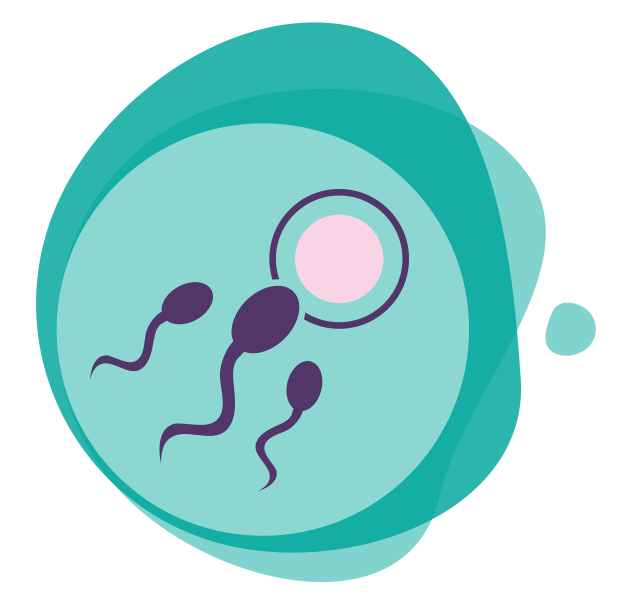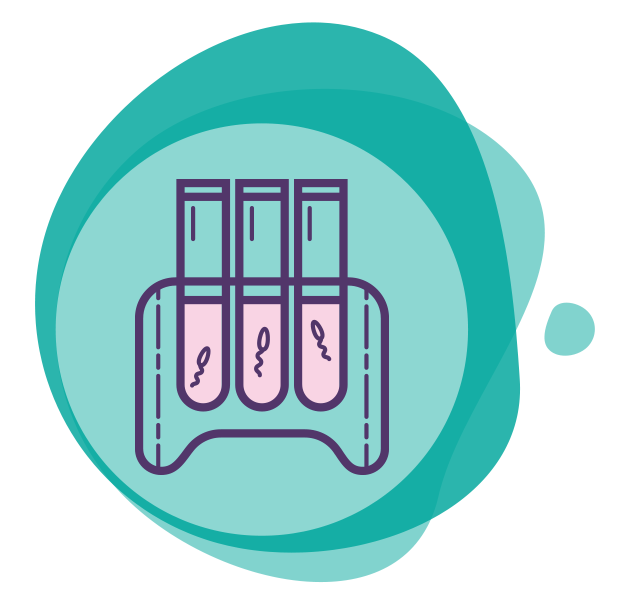Terminology
This process is performed only when good quality embryos form in addition to those having already been implanted in the womb. Future use of frozen embryos is performed upon agreement of the parties during later treatment – if any – or for implantation in a surrogate carrier and for implantation in the womb at a later date pending the future mother’s health conditions. Embryo freezing can be done at four points in time during the initial IVF procedure cycle: On the first, second and third days of fertilization, or at the blastocyst stage. Frozen embryos are preserved at -196 celsius (centigrade) degrees in a liquid nitrogen coolant environment. The majority of IVF clinics freeze embryos by vitrification method. Vitrification has proven to facilitate survival rates in over 90 percent of long-term stored embryos and ova.
A sperm bank is a specially outfitted and equipped facility where a private client’s sperm – or donor sperm – specimens are stored in liquid nitrogen at the deep freezing temperature of -196 celsius degrees. Sperm can be preserved at this temperature for many years. A general rule of thumb is that if the condition and quality of the sperm was good at the freezing process stage, survival chances are high at time of thawing.
Gametes, Oocytes, Ovum and Sperm are names of the cells that fuse during fertilization to form an embryo. Female gametes are better known as ova (eggs). Male gametes are commonly known as sperm cells.
In Vitro Fertilization is medical as well as the common reference to the process of fertilizing ova under laboratory conditions in a test tube. This is in contrast with natural occurring fertilization, otherwise referred to as In Utero fertilization.
ART stands for Assisted Reproductive Treatment and Assisted Reproductive Technology.
This is a general acronym phrase used mostly by professionals in the field of IVF and assisted reproduction procedures at large.
Also referred to as FET – Frozen Embryo Transfer. The practice at most clinics is to thaw the embryos upon arrival of the woman / couple for the purpose of implantation. An embryo is then thawed to reach body temperature – 37 degrees celsius – by effect of specialized solutions in stages at varying concentrations. The process then follows the same protocol as IVF (in vitro fertilization) implantation. Since any embryonic cell can theoretically split to form another embryo, tests are performed to determine survival rates of cells within the embryo. Hence, even if only half of the embryo cellular structure survives the thawing process, it can still be readied for reimplantation into the womb. Success rates of FET derived treatments are almost as good as a fresh IVF round of treatment. However, one must take into account causes that affect these rates considerably, among them are the age of the woman and the number of embryos being reimplanted.
A sperm cell is a fertilizing cell produced by males. Each sperm cell contains 23 sets of chromosomes as does the female ovum (egg). Sperm cells differ from ova in that they occur in unique Y and X versions. Ova occur in X version only. Fusion of a Y sperm cell with an ovum will develop into a male (XY) embryo whereas by X sperm cell fertilization, an egg will develop and form into a female (XX) embryo.
Sperm cells are commonly divided into 3 sections: head, midpiece and tail. All 3 parts are necessary to cause successful fusion with the ovum.
An embryo is the result of successful fusion of sperm with ova. Once fusion occurs, the embryo then begins to split into cells. At a later stage, the embryo is also referred to as a blastocyst.
Defined as the branches of science and medicine dealing with male reproductive functions under physiological and pathological conditions.
A fertility treatment, involving placement of a sperm sample collected from a male inside
A group of fertility therapies that employ manipulations of the egg (oocyte) and sperm in the laboratory in order to establish a pregnancy. These include In Vitro Fertilization
(IVF), Intracytoplasmic Sperm Injection (ICSI), donor egg cycles, assisted hatching, preimplantation genetic diagnosis (PGD) and others.
An infertility condition in men defined by the lack of sperm cells in repeated examination by qualified
professionals. Azoospermia is divided in two main types: Obstructive and non-obstructive. Obstructive azoospermia (OA)
is defined as the absence of spermatozoa in the ejaculate despite normal spermatogenesis (i.e. production of mature
sperm cells). OA is a common urologic condition and accounts for 6.1% to 13.6% of patients presenting for fertility
evaluation. Vasectomy is a frequent cause of OA; however, alternate etiologies such as infection, iatrogenic injury, and
genetic and congenital conditions are all possible causes of OA are frequently encountered. Non‐obstructive
azoospermia (NOA) is defined as no sperm in the ejaculate due to failure of spermatogenesis and is the most severe
form of male infertility. The etiology of NOA is either intrinsic testicular impairment, resulting from chromosomal or
genetic abnormalities, or inadequate gonadotropin production. The procedures for treating each type of azoospermia
are distinct. In cases of NOA, the reason for the condition will probably be unknown. The research into the condition is
still ongoing; many aspects are yet to be uncovered.
Eggs that are harvested via an in vitro fertilization (IVF) cycle performed on the donor
(anonymous or known donor). The harvested eggs are inseminated with sperm in the lab to form embryos which are transferred into the womb of the intended parent.
A medical professional whose expertise is in reproductive medical procedures, or a researcher
who studies embryology. Embryology is the science of studying embryo development, usually applied to all development before birth (in humans, included both the embryonic and fetal period).
Fertility preservation is the process of saving or protecting eggs, sperm, or reproductive tissue so that a person can use them to have biological children in the future. People (male or female) with certain diseases, disorders, and life events that affect fertility may benefit from fertility preservation. These include people who: Have been exposed to toxic chemicals in the workplace or during military duty, have endometriosis, have uterine fibroids, are
about to be treated for cancer, are about to be treated for an autoimmune disease (such as lupus), have a genetic
disease that affects future fertility, delay having children.
A number of fertility-preserving options are available. Fertility-preserving options for males include: Sperm
cryopreservation and gonadal shielding. In cryopreservation, a male provides samples of his semen. The semen is then
frozen and stored for future use in a process called cryopreservation. In gonadal shielding, radiation treatment for cancer and other conditions can harm fertility, especially if it is used in the pelvic area. Some radiation treatments use modern techniques to aim the rays on a very small area. The testicles can also be protected with a lead shield.
Fertility-preserving options for females include: Embryo cryopreservation, oocyte cryopreservation, gonadal shielding, ovarian transposition. Embryo cryopreservation, also called embryo freezing, is the most common and successful option for preserving a female's fertility. First, a health care provider removes eggs from the ovaries. The eggs are then fertilized with sperm from her partner or a donor in a lab in a process called in vitro fertilization. The resulting embryos are frozen and stored for future use. Oocyte cryopreservation is similar to embryo cryopreservation, except that unfertilized eggs are frozen and stored. Gonadal shielding for women is similar to gonadal shielding for males. Steps are taken, such as aiming rays at a small area or covering the pelvic area with a lead shield, to protect the ovaries from
radiation. In ovarian transposition, a health care provider performs a minor surgery to move the ovaries and sometimes the fallopian tubes from the area that will receive radiation to an area that will not receive radiation. For example, they may be relocated to an area of the abdomen wall that will not receive radiation.
Some of these options, such as sperm, oocyte, and embryo cryopreservation, are available only to males and females
who have gone through puberty and have mature sperm and eggs. However, gonadal shielding and ovarian
transposition can be used to preserve fertility in children who have not gone through puberty.
Placement of a single sperm into a single egg by penetrating the outer coatings of the egg. This technique is used in cases where there are very low sperm numbers, motility or morphology. ICSI is also used for patients who have had previous in vitro fertilization (IVF) cycles with failed fertilization.
Also referred to as an egg, is the female germ cell.
Ovarian tissue freezing is a type of fertility preservation. It may be useful for women who want
to have children after having treatment that may cause infertility, such as certain cancer treatments. Also called ovarian
tissue banking and ovarian tissue cryopreservation. In this process, part or all of an ovary is removed, and the tissue that
contains the eggs is cut into thin slices and frozen. The tissue may later be thawed and placed back into the woman’s
body, usually on the remaining ovary.
A woman who gets artificially inseminated with the father’s sperm in order to produce a fertilized egg, the procedure is called surrogacy. Currently, there are two types of surrogacy — traditional surrogacy and gestational surrogacy. In traditional surrogacy, a surrogate mother is artificially inseminated, either by the intended father or an anonymous donor, and carries the baby to term. The child is thereby genetically related to both the surrogate mother, who provides the egg, and the intended father or anonymous donor. In gestational surrogacy, an egg is removed from the intended mother or an anonymous donor and fertilized with the sperm of the intended father or anonymous donor. The fertilized egg, or embryo, is then transferred to a surrogate who carries the baby to term. The child is thereby genetically related to the woman who donated the egg and the intended father or sperm donor, but not the surrogate.
The surgical removal of sperm directly from the testis or the epididymis using a needle for aspiration. This procedure is used for men who have no sperm in their ejaculates or have had vasectomies in the past. Sperm obtained through TESE requires Intracytoplasmic Sperm Injection (ICSI) to ensure fertilization of an egg.








